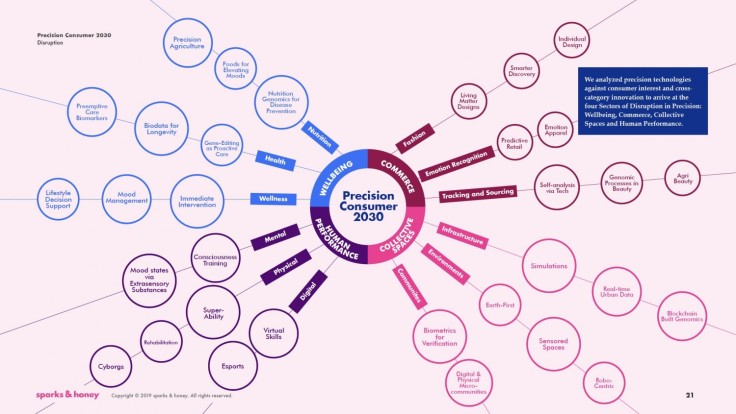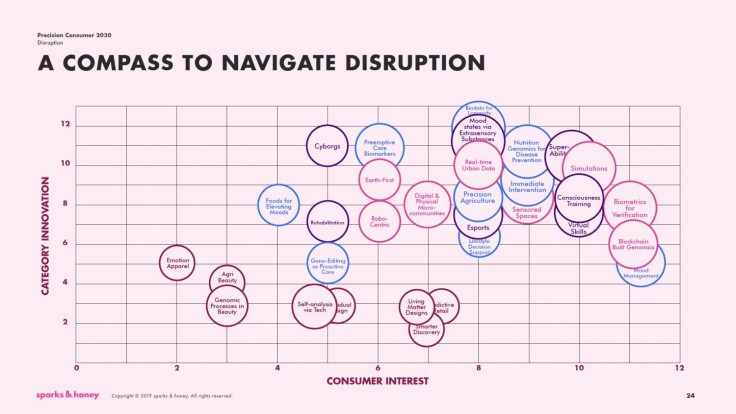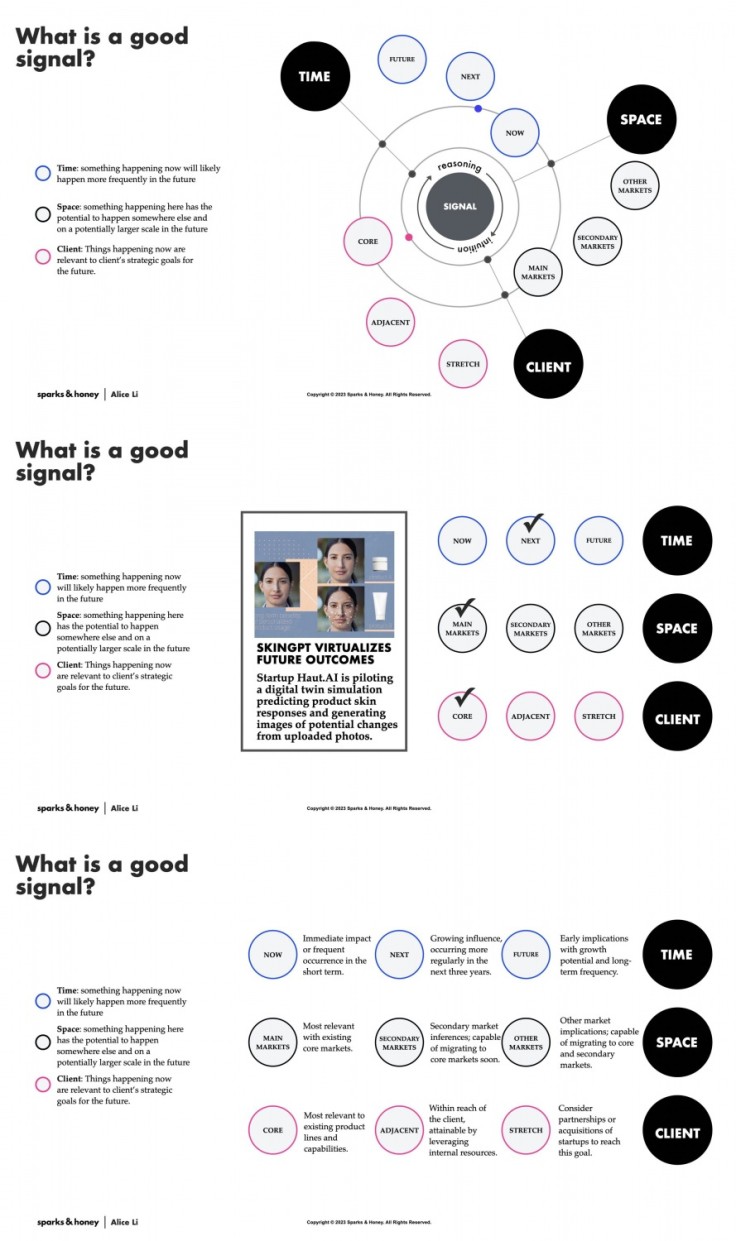
In an era of constant change and rapid innovation, the role of strategic foresight is paramount. I serve as the director of cultural strategy and innovation at sparks & honey, a forward-looking consultancy under Omnicom Group, we harness technology-driven cultural intelligence to help organizations navigate the tumultuous seas of global mega and macro shifts. Our mission is clear: to empower businesses to not just keep up with the ever-accelerating pace of change but to stay ahead of it. Our work at s&h primarily addresses three key challenges: NOW, realigning cultural relevance; NEXT, mapping and prioritizing opportunities to inform product innovation; and FUTURE, global shift stacking, strategic 2030 planning, disruption compass, and business transformation. Within the organization, I lead the majority of FUTURE projects.
Designing the Menu of Opportunity
In my previous roles at other agencies, frequently, when receiving a brief, the product was already well into development. Drafting narratives for products with social impact and the potential to influence cultural dialogues can contribute to the betterment of society. However, I found myself increasingly drawn to the early stages of decision-making, which is why I transitioned to future-focused consulting. In the realm of strategic foresight, I am involved from the outset of the process. We identify and thoroughly assess all potential opportunities while designing frameworks that guide prioritizing investment and innovation.
Fortune 500 clients typically have extensive product portfolios and product development pipelines that span the next 5 to 15 years. Our identified opportunities cover a wide spectrum, from the most prominent and obvious to the fringe and watchful. While some opportunities presented to clients may not be entirely new given their industry immersion, what our C-suite clients find most valuable is our ability to quantify opportunities and comprehensively map them onto a clear timeline, gauging innovation feasibility and market readiness, therefore facilitating prioritization for investment. From established opportunities that indicate a strong win in the short term to emerging opportunities with growing demands not fully addressed by the market to plateauing opportunities with growth potential and relevancy, we score and quantify all potential opportunities into a roadmap of actionability. We effectively guide our C-suite clients through the decision-making process and plan innovation pipelines with a clear timeline. If I were to use a metaphor, while many agencies prepare individual dishes, our future consultancy designs the best menu. Despite our framework's heavy reliance on data, we maintain flexibility to guide opportunity selection based on planned timeframes and our clients' unique circumstances.

Fearless Creativity Meets Long-Term Analysis
Compared to NEXT projects, FUTURE projects look ahead to the coming decade. There may not be as much existing evidence and data available. Therefore, a certain level of creativity is essential to formulate hypotheses based on early signals and data. A foresight project is a fusion of fearless creativity in narrative creation based on early signals and a rigorous analysis of long-term indicators, encompassing macro level factors such as social, political, economic, technological, and environmental megashifts. Identifying signals is an entry-level yet critical skill for a futurist. I've developed a structure that breaks down the concept of a signal into two dimensions: time and space. Time: Something happening now will likely occur more frequently in the future. Space: Something happening here has the potential to happen elsewhere and on a potentially larger scale in the future. A third dimension can be applied to unique client situations. Client: Things happening now are relevant to the client's strategic goals for the future.
Below is a brief overview of the three dimensions:
● Time
○ Now: Immediate impact or frequent occurrence in the short term.
○ Next: Growing influence, occurring more regularly in the next three years.
○ Future: Early implications with growth potential and long-term frequency.
● Space:
○ Main markets: Most relevant to existing core markets.
○ Secondary markets: Secondary market inferences; capable of migrating to core markets soon.
○ Other markets: Other market implications; capable of migrating to core and secondary markets.
● Client:
○ Core: Most relevant to existing product lines and capabilities.
○ Adjacent: Within reach of the client, attainable by leveraging internal resources.
○ Stretch: Consider partnerships or acquisitions of startups to reach this goal.
Another indicator involves assessing the stage of new discoveries, such as their clinical trial phase. This assessment allows us to make informed hypotheses about when they are likely to reach the market and the potential impact they will have. Other relevant indicators to consider include movements in venture capital, the growth rate of start-up companies, and patent activity. It's worth noting that products often take several years to reach the market after the initial patent filing. Consequently, patent analysis also offers valuable insights for making future predictions and impact assessments.

Cocreating Preferable Futures
Data is just one facet of the story; our clients often welcome our expert suggestions and perspective on opportunity selection that goes beyond data. This offers us the chance to provide a more comprehensive perspective on cultural context, which, in turn, influences decisions and allows us to co-create preferable futures with our Fortune 500 clients. For example, when prioritizing two opportunities, we might recommend the one that aligns with sustainable materials. In our FUTURE projects, we assist clients in understanding large-scale global shifts over the next 10 years. We might suggest transitioning to renewable energy operations by 2030, supported by data, to demonstrate that this move is not only a moral choice but also a critical business decision. It's this tangible impact that truly makes global foresight consulting a meaningful pursuit.
About the Author, Alice Li
Alice is the director of cultural strategy and innovation at sparks & honey, a future-focused consultancy affiliated with the Omnicom Group that leverages tech-led cultural intelligence to help organizations understand mega and macro global shifts and stay ahead of accelerating change. s&h typically solves three types of problems: NOW, realigning cultural relevance; NEXT, opportunities mapping and prioritization to inform product innovation; and FUTURE, global shift stacking, strategic 2030, disruption compass, and business transformation. She is the go-to expert for future framework and leads most FUTURE projects at sparks & honey. As a quantitative futurist with a demonstrated history in foresight and innovation strategy, Alice has consulted with numerous C-suite executives of Fortune 100 businesses to support their decision-making processes.
In addition to her career in C-suite management consulting, Alice is a prestigious judge for international design awards such as the MUSE Design Awards and the iLuxury Awards. She aims to equip the design community with diverse cultural resources and strategic foresights. This, in turn, can enable the next generation to make future-proof design choices and become responsible and reflective members of society as they embark on making meaningful contributions to the world.









